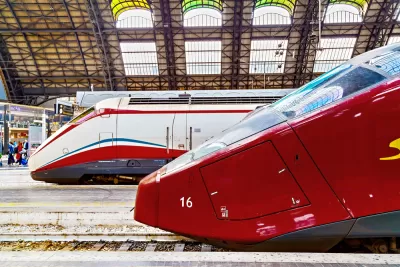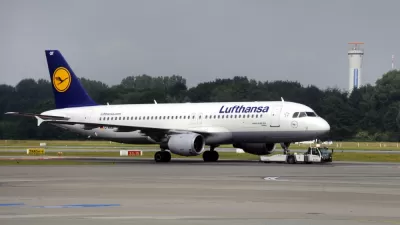European countries are committing to making intercity rail the preferable option compared to domestic and intra-continental flights. The shift seems to be working in Italy.

Over two thirds of people traveling between Roma and Milan take the train, with the number of passengers on the route (the main business route in Italy) quadrupling over the past decade. The trend in Italy reflects a broader cultural movement in Europe and achieves the desired effect of specific policy efforts of countries like Germany and France.
An article by Julia Buckley speculates about whether the success of intercity rail in Italy contributed to the demise of Alitalia—the national airline is shutting down business today.
According to the article, Alitalia tended to focus on domestic flights, so it "was a bird with its wings very much clipped from the start." The article mostly credits the demise of the airline on the market, not public policy. According to sources cited in the article, a "cocktail" of low-cost airlines and high-speed trains proved too much competition for the airline. On the rail side, there are now two high-speed rail companies (one public, Trenitalia, and one private, Nuovo Trasporto Viaggiatori) to choose from, and the rail infrastructure of the country is dramatically improved from the country's past.
According to Buckley's sources, tourists and Italians alike find the trains easier, cheaper, and quicker than flying. The consequences of this shift have spread to other sectors of the economy as well. "While real estate prices in Milan dipped 20.5% from 2008 to 2018, prices for offices around the high-speed stations of Rogoredo and Porta Garibaldi were up around 10%," according to Buckley.
FULL STORY: How Italy's high-speed trains helped kill Alitalia

Trump Administration Could Effectively End Housing Voucher Program
Federal officials are eyeing major cuts to the Section 8 program that helps millions of low-income households pay rent.

Planetizen Federal Action Tracker
A weekly monitor of how Trump’s orders and actions are impacting planners and planning in America.

Ken Jennings Launches Transit Web Series
The Jeopardy champ wants you to ride public transit.

Rebuilding Smarter: How LA County Is Guiding Fire-Ravaged Communities Toward Resilience
Los Angeles County is leading a coordinated effort to help fire-impacted communities rebuild with resilience by providing recovery resources, promoting fire-wise design, and aligning reconstruction with broader sustainability and climate goals.

When Borders Blur: Regional Collaboration in Action
As regional challenges outgrow city boundaries, “When Borders Blur” explores how cross-jurisdictional collaboration can drive smarter, more resilient urban planning, sharing real-world lessons from thriving partnerships across North America.

Philadelphia Is Expanding its Network of Roundabouts
Roundabouts are widely shown to decrease traffic speed, reduce congestion, and improve efficiency.
Urban Design for Planners 1: Software Tools
This six-course series explores essential urban design concepts using open source software and equips planners with the tools they need to participate fully in the urban design process.
Planning for Universal Design
Learn the tools for implementing Universal Design in planning regulations.
Ada County Highway District
Clanton & Associates, Inc.
Jessamine County Fiscal Court
Institute for Housing and Urban Development Studies (IHS)
City of Grandview
Harvard GSD Executive Education
Toledo-Lucas County Plan Commissions
Salt Lake City
NYU Wagner Graduate School of Public Service





























